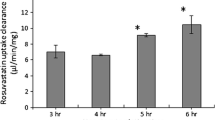Abstract
The objective of the present study was to investigate the uptake process of 4-Phenylazobenzoxycarbonyl-Pro-Leu-Gly-Pro-D-Arg (Pz-peptide), a hydrophilic and collagenase-labile pentapeptide, by isolated hepatocytes. For comparison, the uptake of Pz-peptide by Caco-2 cells and colonic cells, two known paracellular routes of Pz-peptide, was also evaluated. A simple and sensitive reversed-phase HPLC assay method using UV detection has been developed. The coefficient of variation for all the criteria of validation were less than 15%. The method was, therefore, considered to be sutable for measuring the concentration of Pz-peptide in the biological cells. Pz-peptide was extensively uptaked into hepatocytes. The initial velocity of Pzpeptide uptake assessed from the initial slope of the curve was plotted as Eadie-Hofstee plots. Themaximum velocity (Vmax) and the Michaelis constant (Km) were 0.190±0.020 nmol/min/ 106 cells and 12.1±3.23 μM, respectively. The permeability-surface area product (PSinflux) was calculated to be 0.0157 ml/min/106 cells. Vmax and Kmvalues for Caco-2 cells were calculated to be 6.22±0.930 pmol/min/106 cells and 82.8±8.37μM, respectively, being comparable with those of colonocytes (6.04±1.03 pmol/min/106 cells and 87.8±13.2 μM, respectively). PSininflux values for Caco-2 cells and colonocytes were calculated to be 0.0751 μl/min/106 cells and 0.0688 μl/min/10 6 cells, respectively. The more pronounced uptake of Pz-peptide by hepatocytes, when compared with Caco-2 cells and colonocytes, is probably due to its specific transporter. In conclusion, Pz-peptide, a paracellularly transported pentapeptide in the intestine and ocular epithelia, was uptaked into hepatocytes extensively. Although Pz-peptide is able to be uptaked into the Caco-2 cells and colonocytes, it is less pronounced when compared with hepatocytes. PSinflux values of Caco-2 cells and colonocytes for unbound Pz-peptide under linear conditions were less than 0.4% when compared with that of hepatocytes.
Similar content being viewed by others
References
Baur, H., Kasperek, S. and Pfaff, E., Criteria of viability of isolated liver cells.Heppe-Seyler’s Z. Physiol. Chem., 356, 827–838 (1975).
Brown, S. S. and Spudich, J. A., Mechanism of action of cytochalasin: Evidence that it binds to actin filament end.J. Celf Bioi., 46, 163–197 (1990).
Chung, Y. B., Han, K., Nishiura, A. and Lee, V. H. L., Ocular absorption of Pz-peptide and its effect on the ocular systemic pharmacokinetics of topically applied drugs in the rabbit.Pharm. Res., 15, 1882–1887 (1998).
Gibson-D’Ambrosio, R. E., Samuel, M. and D’Ambrosio S. M., A method for isolating large numbers of viable disaggregated cells from various human tissues for cell culture establishment.In Vitro Cellular & Developmental Biology, 22, 529-34 (1986). Iga, T, Eaton, D. L. and Klaassen, C. D., Uptake of unconjugated bilirubin by isolated hepatocytes.Am. J. Hepatol., 236, C9–14 (1979).
Kompella, U. B., Kim K. -J., and Lee, V. H. L., Active chloride transport in the pigmented rabbit conjunctiva.Curro Eye Res., 12, 1041–1048 (1993).
Lin, J. H., Sugiyama, Y., Awazu, S. and Hanano, M., Physiological Pharmacokinetics of ethoxybenzamide based on biochemical data obtained in vitro.J. Pharmacokinet. Biopharm., 10, 649–661 (1982).
Yamaoka, K., Tanigawara, Y., Nakagawa, Y. and Uno, T., A pharmacokinetic analysis program (MULTI) for microcomputer.J. Pharmacobio-Dyn., 4, 879–885 (1981).
Yamazaki, M., Suzuki, H., Iga, T. and Hanano, M., Uptake of organic anions by isolated rat hepatocytes: a classification in terms of ATP-dependency.J. Hepatol., 14, 41–47 (1992).
Yamazaki, M., Suzuki, H. and Hanano, M., Na-independent multispecific anion transporter mediates active transport of pravastatin into rat liver.Am. J. Phsiol., 264, G36-G44 (1993).
Yen W.-C. and Lee, V. H. L., Paracellular transport of a proteolytically labile pentapeptide across the colonic and other intestinal segments of the albino rabbit: implications for peptide drug design.J. Contr. ReI., 28, 97–109 (1994).
Yen W.-C. and Lee, V. H. L., Penetration enhancement effect of Pz-peptide, a paracelullarly transported peptide, in rabbit intestinal segments and Caco-2 cell monolayers.J. Contr. Rei., 36, 25–37 (1995).
Yen W.-C. and Lee, V. H. L., Role of Na+ in the asymmetric paracellular transport of 4-phenylazobenzyloxycarbonyl-LPro-L-Leu-Gly-L-Pro-D-Arg across rabbit colonic segments and Caco-2 cell monolayers.J. Pharmaco/. Exp. Therap., 275, 114–119 (1995).
Author information
Authors and Affiliations
Corresponding author
Rights and permissions
About this article
Cite this article
Shin, T.H., Lee, P.S., Kwon, OS. et al. Extensive hepatic uptake of Pz-peptide, a hydrophilic proline-containing pentapeptide, into isolated hepatocytes compared with colonocytes and Caco-2 cells. Arch Pharm Res 26, 70–75 (2003). https://doi.org/10.1007/BF03179935
Received:
Issue Date:
DOI: https://doi.org/10.1007/BF03179935




